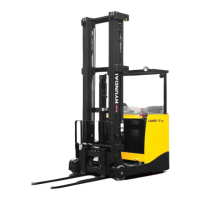Check the operation of the truck as follows.
Before performing these checks, familiarize yourself with the operating procedures in Section
5.
Test warning devices, horn, lights, and other safety equipment and accessories.
With the truck on, check the diagnostic display, or the hour meter and battery discharge indicator
(depending on which truck you have). The diagnostic display should show the charge remaining on
the battery or a fault code. If the fault code is not an operator fault code call a service technician.
Be sure all controls and systems operate freely and return to neutral properly. Check the:
Service brakes
Hydraulic controls : lift, tilt, reach and auxiliary (If installed)
Accelerator control
Directional control
Steering system
Lift mechanism and any attachments
ÂÂ
When the functional checks are completed:
Bring truck to complete stop.(Release brake pedal completely)
Put directional control switch in the NEUTRAL position.
Lower the lift mechanism fully.
Turn the start switch to the OFF position.
Â
If you are going to leave the truck unattended:
Remove the key.
Block the wheels, if the truck is parked on an incline or has the possibility of moving.
4-3
3. FUNCTIONAL CHECKS
1)
2)
3)
(1)
(2)
(3)
(4)
(5)
(6)
Η
Θ
Ι
Κ
ö
Μ
Ν
44. CONCLUDING THE INSPECTION
Make a record on the "Driver's Daily Checklist" of all the operating and truck problems that you find.
Review the checklist to be sure it has been completed and turn it into the person responsible for lift
truck maintenance. Be sure any unusual noises or problems are investigated immediately.
B15AOM87
Do not operate a lift truck that has a
maintenance problem, or is not safe to
operate.
Remove the key from the starting switch and
put an
"OUT OF SERVICE
"
tag on the truck.
If all of the Daily Inspection checks were
normal or satisfactory, the truck can be
operated.

